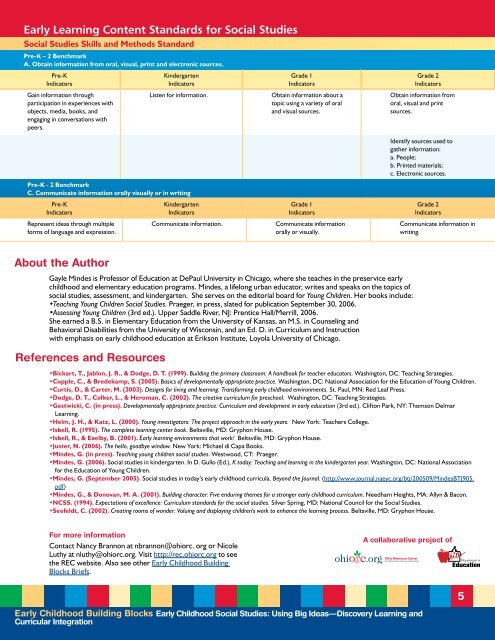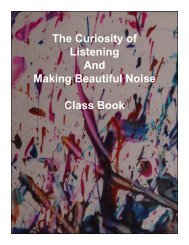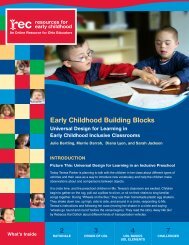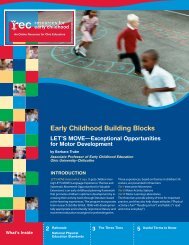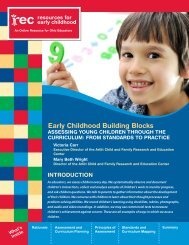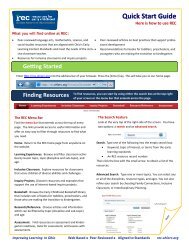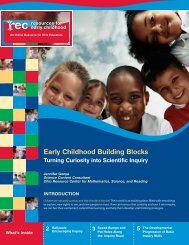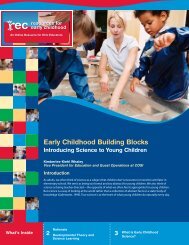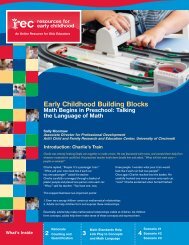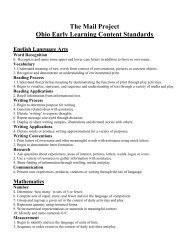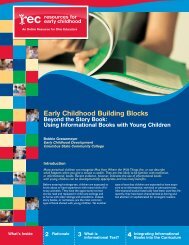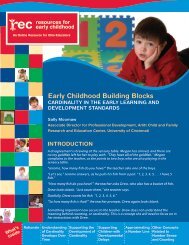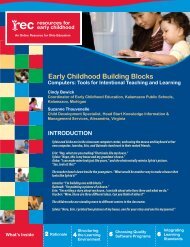Early Childhood Social Studies - Resources for Early Childhood
Early Childhood Social Studies - Resources for Early Childhood
Early Childhood Social Studies - Resources for Early Childhood
You also want an ePaper? Increase the reach of your titles
YUMPU automatically turns print PDFs into web optimized ePapers that Google loves.
<strong>Early</strong> Learning Content Standards <strong>for</strong> <strong>Social</strong> <strong>Studies</strong><br />
<strong>Social</strong> <strong>Studies</strong> Skills and Methods Standard<br />
Pre-K – 2 Benchmark<br />
A. Obtain in<strong>for</strong>mation from oral, visual, print and electronic sources.<br />
Pre-K<br />
Indicators<br />
Gain in<strong>for</strong>mation through<br />
participation in experiences with<br />
objects, media, books, and<br />
engaging in conversations with<br />
peers.<br />
References and <strong>Resources</strong><br />
Kindergarten<br />
Indicators<br />
Pre-K - 2 Benchmark<br />
C. Communicate in<strong>for</strong>mation orally visually or in writing<br />
Pre-K<br />
Indicators<br />
Represent ideas through multiple<br />
<strong>for</strong>ms of language and expression.<br />
About the Author<br />
•Bickart, T., Jablon, J. R., & Dodge, D. T. (1999). Building the primary classroom: A handbook <strong>for</strong> teacher educators. Washington, DC: Teaching Strategies.<br />
•Copple, C., & Bredekamp, S. (2005). Basics of developmentally appropriate practice. Washington, DC: National Association <strong>for</strong> the Education of Young Children.<br />
•Curtis, D., & Carter, M. (2003). Designs <strong>for</strong> living and learning: Trans<strong>for</strong>ming early childhood environments. St. Paul, MN: Red Leaf Press.<br />
•Dodge, D. T., Colker, L., & Heroman, C. (2002). The creative curriculum <strong>for</strong> preschool. Washington, DC: Teaching Strategies.<br />
•Gestwicki, C. (in press). Developmentally appropriate practice: Curriculum and development in early education (3rd ed.). Clifton Park, NY: Thomson Delmar<br />
Learning.<br />
•Helm, J. H., & Katz, L. (2000). Young investigators: The project approach in the early years. New York: Teachers College.<br />
•Isbell, R. (1995). The complete learning center book. Beltsville, MD: Gryphon House.<br />
•Isbell, R., & Exelby, B. (2001). <strong>Early</strong> learning environments that work! Beltsville, MD: Gryphon House.<br />
•Juster, N. (2006). The hello, goodbye window. New York: Michael di Capa Books.<br />
•Mindes, G. (in press). Teaching young children social studies. Westwood, CT: Praeger.<br />
•Mindes, G. (2006). <strong>Social</strong> studies in kindergarten. In D. Gullo (Ed.), K today: Teaching and learning in the kindergarten year. Washington, DC: National Association<br />
<strong>for</strong> the Education of Young Children.<br />
•Mindes, G. (September 2005). <strong>Social</strong> studies in today’s early childhood curricula. Beyond the Journal. (http://www.journal.naeyc.org/btj/200509/MindesBTJ905.<br />
pdf)<br />
•Mindes, G., & Donovan, M. A. (2001). Building character: Five enduring themes <strong>for</strong> a stronger early childhood curriculum. Needham Heights, MA: Allyn & Bacon.<br />
•NCSS. (1994). Expectations of excellence: Curriculum standards <strong>for</strong> the social studies. Silver Spring, MD: National Council <strong>for</strong> the <strong>Social</strong> <strong>Studies</strong>.<br />
•Seefeldt, C. (2002). Creating rooms of wonder: Valuing and displaying children's work to enhance the learning process. Beltsville, MD: Gryphon House.<br />
For more in<strong>for</strong>mation<br />
Contact Nancy Brannon at nbrannon@ohiorc. org or Nicole<br />
Luthy at nluthy@ohiorc.org. Visit http://rec.ohiorc.org to see<br />
the REC website. Also see other <strong>Early</strong> <strong>Childhood</strong> Building<br />
Blocks Briefs.<br />
Grade 1<br />
Indicators<br />
Listen <strong>for</strong> in<strong>for</strong>mation. Obtain in<strong>for</strong>mation about a<br />
topic using a variety of oral<br />
and visual sources.<br />
Kindergarten<br />
Indicators<br />
Grade 1<br />
Indicators<br />
Communicate in<strong>for</strong>mation. Communicate in<strong>for</strong>mation<br />
orally or visually.<br />
Gayle Mindes is Professor of Education at DePaul University in Chicago, where she teaches in the preservice early<br />
childhood and elementary education programs. Mindes, a lifelong urban educator, writes and speaks on the topics of<br />
social studies, assessment, and kindergarten. She serves on the editorial board <strong>for</strong> Young Children. Her books include:<br />
•Teaching Young Children <strong>Social</strong> <strong>Studies</strong>. Praeger, in press, slated <strong>for</strong> publication September 30, 2006.<br />
•Assessing Young Children (3rd ed.). Upper Saddle River, NJ: Prentice Hall/Merrill, 2006.<br />
She earned a B.S. in Elementary Education from the University of Kansas, an M.S. in Counseling and<br />
Behavioral Disabilities from the University of Wisconsin, and an Ed. D. in Curriculum and Instruction<br />
with emphasis on early childhood education at Erikson Institute, Loyola University of Chicago.<br />
A collaborative project of<br />
<strong>Early</strong> <strong>Childhood</strong> Building Blocks <strong>Early</strong> <strong>Childhood</strong> <strong>Social</strong> <strong>Studies</strong>: Using Big Ideas—Discovery Learning and<br />
Curricular Integration<br />
Grade 2<br />
Indicators<br />
Obtain in<strong>for</strong>mation from<br />
oral, visual and print<br />
sources.<br />
Identify sources used to<br />
gather in<strong>for</strong>mation:<br />
a. People;<br />
b. Printed materials;<br />
c. Electronic sources.<br />
Grade 2<br />
Indicators<br />
Communicate in<strong>for</strong>mation in<br />
writing.


